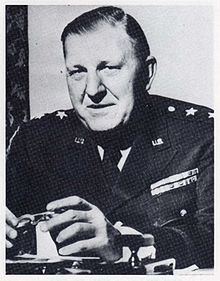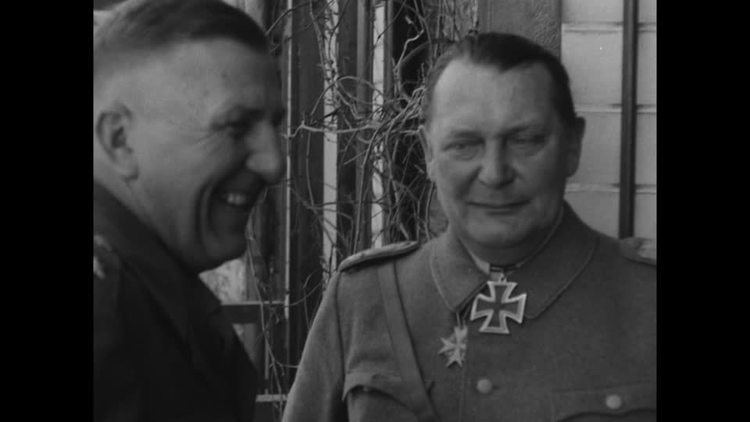Years of service 1917-1956 | Name John Dahlquist | |
 | ||
Born March 12, 1896Minneapolis, Minnesota ( 1896-03-12 ) Commands held Army Field ForcesU.S. Continental Army Command4th ArmyV Corps70th Infantry Division36th Infantry Division1st Infantry Division Awards Distinguished Service CrossDistinguished Service Medal (2)Silver StarLegion of MeritBronze Star Medal (2) Place of burial Arlington National Cemetery, Arlington, Virginia, United States | ||
Battles/wars World War IICold War Allegiance United States of America | ||
General John Ernest Dahlquist (March 12, 1896 – July 30, 1975) was a senior United States Army officer. In the course of his military career, he commanded three different army divisions, commanded at the corps and field army level, and rose to the rank of four-star general.
Contents

Biography
Born on March 12, 1896 in Minneapolis, Minnesota, the youngest of four children, his parents were immigrants from Dalsland, Sweden. He graduated from the University of Minnesota and received a direct commission as a second lieutenant into the Infantry Branch of the United States Army in August 1917, shortly after the American entry into World War I on April 6, 1917. Unable to serve overseas, he served in the Allied occupation of the Rhineland after the war.
Remaining in the army during the interwar period he returned to the United States and served as an instructor at the U.S. Army Infantry School from 1924 to 1928. After graduating from the U.S. Army Command and General Staff School in 1931, he was assigned to the Philippines. From 1935 to 1936 he was a student at the U.S. Army War College, serving on the U.S. Army General Staff, Personnel Division after graduation.
World War II
With the American entry into World War II, in December 1941, due to the Japanese attack on Pearl Harbor, followed by the German declaration of war on the United States, Dahlquist was sent to England and assigned as deputy chief of staff to Major General Dwight David Eisenhower in early 1942, and, later that year, with the one-star rank of brigadier general, became the assistant division commander (ADC) of the 76th Infantry Division. In June 1943, promoted to the two-star rank of major general, Dahlquist became the first commanding general (CG) of the 70th Infantry Division, becoming one of the youngest division commanders in the U.S. Army. In July 1944 he took command of the 36th Infantry Division, a National Guard formation recruiting from Texas.
It was for his command of the 36th Division, which had fought long and hard in many difficult battles in the Italian Campaign under Major General Frederick Walker and recently taken part in Operation Dragoon, the Allied invasion of Southern France, that Dahlquist received his greatest criticism for his over-utilization of the Japanese American 442nd Regimental Combat Team (442nd RCT). Arguably, his poor decisions would result in the 442nd RCT becoming the most highly decorated unit in the history of the United States Armed Forces. Over a third of the men in the 442nd would be either killed or wounded due to Dahlquist's ordering the unit to rescue another unit that had been surrounded by the enemy. In fact it is not the Nisei soldiers of the 442nd, but their officers (none of them Japanese American) that are often quoted in criticism of Dahlquist.
On 24 October 1944, the 1st and 2nd Battalions of the 141st Infantry Regiment, part of his 36th Division, moved to secure the right flank of the 3rd Division, near the French town of St-Die. When the German forces counterattacked, the 1st Battalion was separated and cut off. After two days of attempted rescue by the other two battalions of the 141st Infantry, Dahlquist resorted to send in the 442nd RCT, which had borne the brunt of the 36th Division's fighting for the previous eight days. The 442nd would suffer 800 casualties, including 121 dead, during the five days it took to rescue 211 men of the 1st Battalion, 141st Infantry. Major General Lucian Truscott, commanding the VI Corps (under which unit the 36th Division was serving), considered relieving him of his command.
On November 12, General Dahlquist announced he wanted to review the 442nd, to thank them for what they had done. When the battered unit appeared, Dahlquist grew irritated at their sparse numbers, ignorant at how much they had sacrificed.
He continued to lead the 36th Division throughout the campaign in Western Europe. On May 8, 1945, Victory in Europe Day, Hermann Göring surrendered to Brigadier General Robert I. Stack, the 36th Infantry Division's ADC after a ceasefire was declared between the German Army Group G and the U.S. Seventh Army. Dahlquist's ADC, Brigadier General Stack, transported Göring to the division command post. Because he also spoke German, Dahlquist dismissed his translator, and so it was Dahlquist who became the first person to question Göring. Press photos of Dahlquist and Stack, in seemingly casual conversation with Göring, were released for publication back in the United States and resulted in criticism of Dahlquist from the American public and from General Eisenhower, the Supreme Allied Commander in the European Theater of Operations (ETO).
Postwar
Following the war, Dahlquist returned to the United States, serving in various administrative and personnel jobs. He took command of his third division, the 1st Infantry, in 1949. This was followed by command of V Corps from 1952 to 1953 and the Fourth Army in 1953. He then served as Chief of Army Field Forces from 1953 to 1955, during which he was promoted to the four-star rank of general on August 18, 1954. He finished his career as Commander-in-Chief (C-in-C), Continental Army Command, retiring in 1956. He died on June 30, 1975, aged 79, and was buried in Arlington National Cemetery, Virginia.[1]
Marriage
Dahlquist was married to Ruth D. Dahlquist, who coincidentally was born 17 days after him, and died 17 days after him. She was buried on top of him in Arlington. They had a son, Donald John Dahlquist, born on March 9, 1932 who died on November 22, 1993, buried in Arlington National Cemetery next to his parents. Dahlquist had two grandchildren, John William and Donette Ruth.
Awards and decorations
Dahlquist's awards and decorations include the Distinguished Service Cross, the Army Distinguished Service Medal, the Silver Star, the Legion of Merit, and the Bronze Star . In 1954 he received an honorary Master of Arts from the University of Minnesota.
